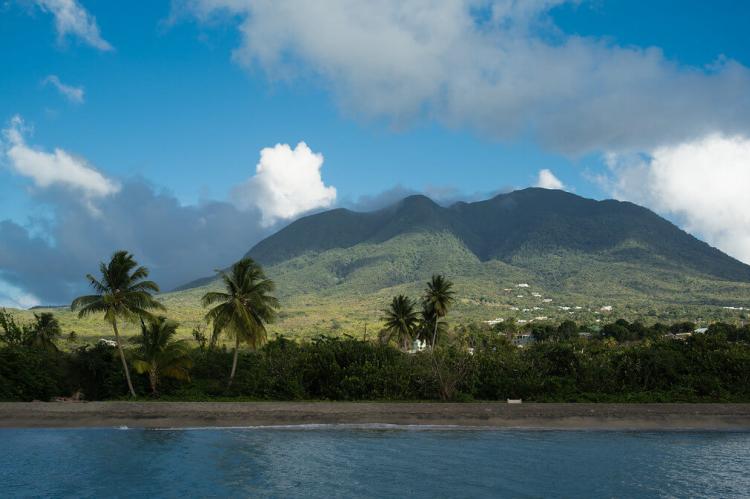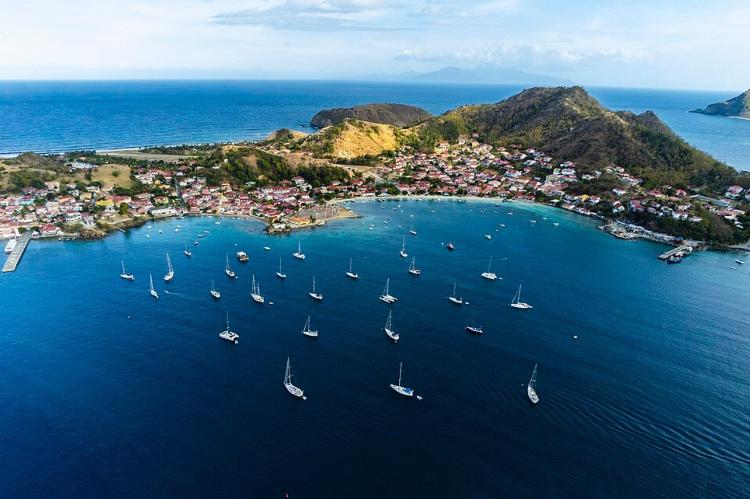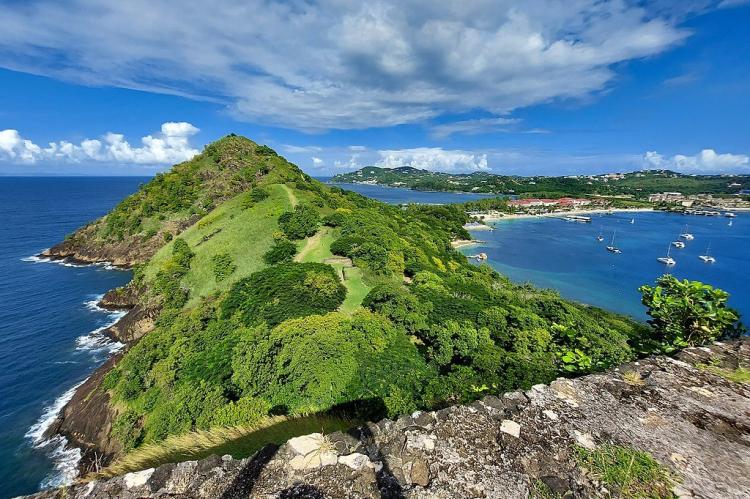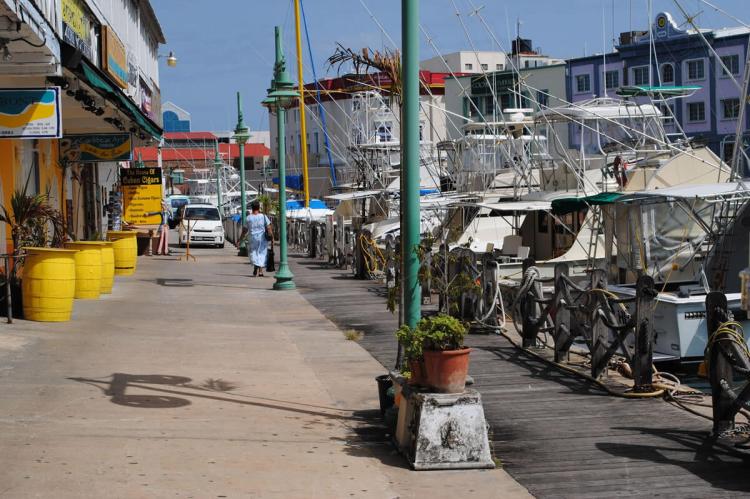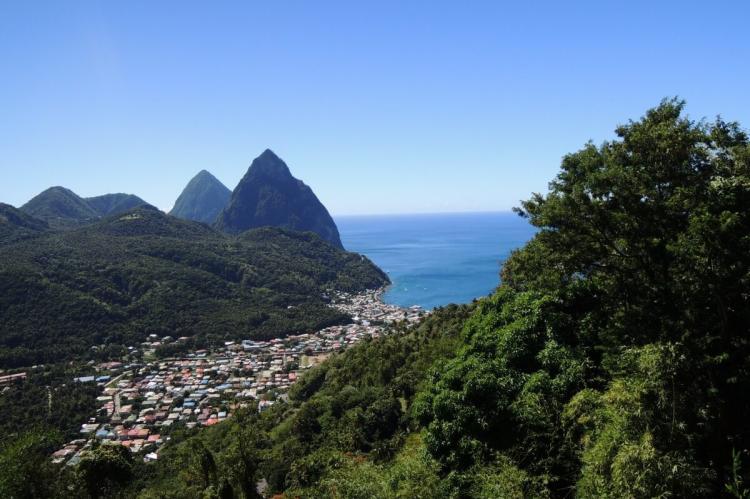The Lesser Antilles: Exploring the Enchanting Diversity of the Caribbean Archipelago
Nestled in the heart of the Caribbean Sea, the Lesser Antilles form an island chain that stretches between the Greater Antilles and South America. Comprising a mix of volcanic and non-volcanic islands, the archipelago boasts stunning landscapes, rich cultural heritage, and unique ecosystems.
The Lesser Antilles: Exploring the Enchanting Diversity of the Caribbean Archipelago
Nestled like jewels in the azure waters of the Caribbean Sea, the Lesser Antilles form an enchanting archipelago that spans the gap between the majestic Greater Antilles and the verdant shores of the South American continent. This diverse chain of islands, a blend of volcanic peaks and coral atolls, presents a captivating tapestry of landscapes, from rugged cliffs to pristine beaches, each offering a glimpse into the region's rich natural heritage and cultural diversity.
It is a realm where lush rainforests cascade down volcanic slopes, vibrant coral reefs teem with marine life, and centuries-old traditions and customs continue to thrive amidst the modern world. For travelers and researchers alike, the Lesser Antilles beckon with promises of adventure, discovery, and an unparalleled immersion into the wonders of the Caribbean.
Geographical Overview
The Antilles is an archipelago (group of islands) in the Caribbean Sea. It comprises all of the West Indies except the Bahamas and Turks and Caicos Islands. The Antilles are divided into two major groups: the Greater Antilles and the Lesser Antilles.
The Lesser Antilles marks the eastern edge of the Caribbean Sea, separating it from the vast Atlantic Ocean. This group of islands is divided into three distinct clusters, each with its charm and personality, making it a natural wonder.
To the north lies the Leeward Islands, offering peaceful beaches and gentle winds that attract sun-seekers and sailors.
- U.S. Virgin Islands
- British Virgin Islands
- Anguilla
- St. Martin & St. Maarten
- Saba
- St. Eustatius
- Saint Kitts and Nevis
- Antigua
- Barbuda
- Montserrat
- Guadeloupe
In the south, the Windward Islands boast rugged terrain and lush rainforests, showcasing nature's raw power.
- Dominica
- Martinique
- Saint Lucia
- Saint Vincent and the Grenadines
- Barbados
- Trinidad and Tobago
Finally, to the southwest, the Leeward Antilles offers a different Caribbean experience, where deserts and turquoise waters meet in a beautiful contrast of colors.
- Aruba
- Curacao
- Bonaire
- Tortuga
- Isla Margarita
Each group of islands within the Lesser Antilles offers a kaleidoscope of landscapes, cultures, and experiences shaped by centuries of geological evolution and human endeavor. It is a region where the past meets the present, nature's beauty reigns supreme, and every island has a story.
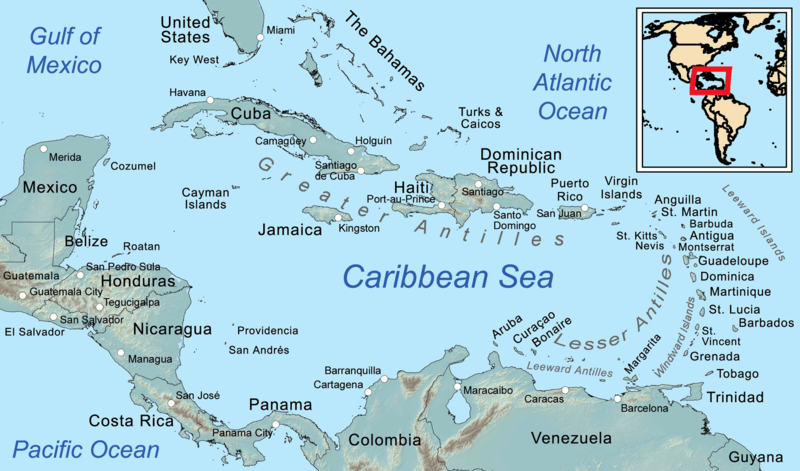
Map depicting the island groups of the Caribbean region: the Lesser Antilles are shown in the southeast.
Leeward Islands: Where the Caribbean Meets the Atlantic
The term "Leeward Islands" specifically refers to the northern islands of the Lesser Antilles chain, where the Caribbean Sea meets the western Atlantic Ocean. These islands are characterized by their sheltered position from prevailing winds. Situated at the northeastern edge of the Caribbean Sea, the Leeward Islands beckon travelers with their pristine beaches, crystalline waters, and verdant landscapes. This enchanting group of islands, extending southeast from the Virgin Islands to Guadeloupe, serves as a gateway to the Caribbean's captivating charm and natural splendor.
The Leeward Islands consist of stunning destinations with unique charm and cultural heritage. Antigua stands out for its secluded bays, historic harbors, and vibrant coral reefs. Visitors can enjoy snorkeling, sailing, and relaxation under the sun in this idyllic setting. Nearby, St. Kitts and Nevis fascinate with their lush rainforests, colonial-era architecture, and volcanic peaks, offering a glimpse into the rich tapestry of Caribbean history and culture. Meanwhile, Anguilla's pristine white-sand beaches, luxurious resorts, and relaxed island vibe make it a paradise for luxury travelers and beach lovers.
Windward Islands: Nature's Splendor in the Southern Caribbean
The Windward Islands in the Caribbean Sea starkly contrast their northern counterparts. They offer a unique sanctuary for biodiversity and natural beauty. These islands span from Dominica's rugged shores to the northern boundaries of Trinidad & Tobago. Dramatic volcanic peaks, verdant rainforests, and vibrant coral reefs define the landscape.
Dominica was once considered part of the Leeward Islands, but due to its location within the southern group, it was later reclassified to the Windward Islands. Known as the "Nature Island," this enchanting place enthralls with its unspoiled wilderness, cascading waterfalls, and geothermal wonders. It offers a glimpse into Mother Nature's breathtaking power and beauty.
The Windward Islands are named after their windward position in relation to the prevailing trade winds that guided the routes of trans-Atlantic sailing ships. These winds, which blow from east to west, have shaped the region's maritime history and continue to influence the climate and ecosystems of the islands today. The Windward Islands are home to a wide variety of biodiversity, from the lush forests of St. Lucia to the pristine reefs of St. Vincent and the Grenadines, making it an ideal place for rare species to thrive amid untouched landscapes and crystal-clear waters.
Adventurers and nature enthusiasts are beckoned to explore the natural splendor of the southern Caribbean's Windward Islands, whether hiking through lush rainforests, snorkeling among colorful coral reefs, or simply unwinding on secluded beaches.
Leeward Antilles: A Gateway to South America
Located in the southeastern part of the Caribbean Sea, the Leeward Antilles are a group of islands known for their beautiful blend of Caribbean culture and South American influences. This chain of islands includes the Dutch ABC islands (Aruba, Bonaire, and Curaçao) and Venezuelan territories, and they feature a diverse range of landscapes, ranging from arid desert scenery to pristine beaches, each providing a unique look into the region's rich natural heritage.
Unlike their volcanic counterparts, the Leeward Antilles were formed due to the intricate geological processes of plate tectonics. The Caribbean Plate has been subducting underneath the South American Plate, causing the formation of a group of islands that showcase the dynamic relationship between land and sea. Recent studies indicate that these islands are slowly attaching to the South American mainland, causing the boundaries between the Caribbean and South America to become blurred.
The Dutch ABC islands, from the bustling streets of Oranjestad in Aruba to the vibrant cultural scene of Willemstad in Curaçao, offer a colorful tapestry of Dutch colonial architecture, vibrant street art, and culinary delights that reflect their rich history and multicultural heritage. In addition, the Venezuelan territories, including Margarita Island and Los Roques Archipelago, are home to pristine beaches, crystal-clear waters, and abundant marine life.
From exploring ancient cave paintings in Cueva del Guácharo National Park to windsurfing along the coast of Bonaire or savoring a traditional Venezuelan arepa on the shores of Margarita Island, the Leeward Antilles invite visitors to embark on a journey of discovery and exploration. Here, Caribbean charm meets South American allure in a mosaic of natural beauty and cultural diversity.
Cultural Diversity and Heritage
Beyond their captivating geological features, the Lesser Antilles are renowned for their vibrant cultures and rich heritage, shaped by the diverse peoples who have called these islands home throughout history. From indigenous tribes to European colonizers and African descendants, the Lesser Antilles reflect a tapestry of traditions that have left indelible marks on the region's history, architecture, cuisine, and customs.
Indigenous tribes, such as the Kalinago (Caribs) and the Arawaks, once inhabited these islands, leaving traces of their ancient civilizations in petroglyphs, pottery, and other archaeological remains. Their legacies endure in the names of places like Dominica, derived from the Kalinago word "Wai'tu kubuli," meaning "tall is her body," a testament to the island's towering peaks and rugged terrain.
European colonizers, including the Spanish, French, British, and Dutch, arrived in the Lesser Antilles in the 15th and 16th centuries, bringing their languages, religions, and cultural practices. The legacy of colonial rule is evident in the architecture of historic cities like Bridgetown in Barbados, where Georgian buildings stand as a reminder of the island's British heritage, and Fort-de-France in Martinique, with its French colonial mansions and boulevards.
African descendants, brought to the islands as enslaved laborers, played a vital role in shaping the culture and identity of the Lesser Antilles. Their contributions are celebrated in the vibrant music, dance, and festivals that define Caribbean culture, from the pulsating rhythms of reggae and soca to the colorful costumes and lively street parades of carnival celebrations.
Visitors to the Lesser Antilles have the opportunity to immerse themselves in this colorful mix of cultural identities, whether sampling traditional dishes like cou-cou and flying fish in Barbados, participating in the colorful J'ouvert celebrations of Trinidad's Carnival, or exploring the historic plantations and sugar mills of St. Kitts and Nevis. In every corner of the Lesser Antilles, the spirit of resilience, creativity, and cultural exchange is alive and thriving in the beauty and diversity of this enchanting region.
Conservation and Environmental Concerns
Amidst the breathtaking beauty of the Lesser Antilles lies a pressing need for conservation and environmental stewardship. While these islands are renowned for their stunning landscapes and rich biodiversity, they face formidable challenges, including climate change, habitat degradation, and pollution. Recognizing the urgency of these threats, concerted efforts are underway to preserve and protect the region's ecosystems for future generations.
Climate change poses a significant threat to the delicate balance of ecosystems in the Lesser Antilles, leading to rising sea levels, increased temperatures, and more frequent extreme weather events. Coastal communities are particularly vulnerable to the impacts of sea-level rise, with the potential for habitat loss, erosion, and saltwater intrusion into freshwater sources. Efforts to mitigate and adapt to these changes are crucial for safeguarding the islands' natural heritage.
Habitat degradation, resulting from urbanization, agriculture, and deforestation, poses another significant challenge to the biodiversity of the Lesser Antilles. Fragmentation of habitats and loss of biodiversity threaten the survival of endemic species and disrupt critical ecological processes. Conservation efforts focus on habitat restoration, protected area management, and reforestation initiatives to combat these threats and preserve the region's unique flora and fauna.
Pollution, both on land and in the surrounding seas, further imperils the health of the Lesser Antilles' ecosystems. Marine pollution from plastic debris, oil spills, and runoff from agricultural and industrial activities threatens aquatic life and coral reefs, vital for supporting fisheries and protecting coastlines from erosion. Sustainable waste management practices, marine protected areas, and public awareness campaigns are essential for addressing these environmental challenges.
In response to these threats, governments, local communities, and conservation organizations collaborate on various initiatives to promote conservation and sustainable development in the Lesser Antilles. Marine conservation projects aim to protect coral reefs, seagrass beds, and marine habitats, while sustainable tourism practices seek to minimize visitors' ecological footprints and promote responsible travel.
By fostering partnerships and embracing innovative solutions, the Lesser Antilles are striving to ensure the long-term sustainability of their precious natural resources. Through collective action and a shared commitment to conservation, these islands are working to safeguard their natural treasures for generations to come, ensuring that future visitors will continue to marvel at the beauty and diversity of this enchanting region.
Conclusion: Safeguarding the Splendor of the Lesser Antilles
In the mosaic of the Caribbean, the Lesser Antilles emerge as a beacon of natural splendor and cultural diversity. This archipelago embodies the essence of Caribbean appeal, from the Leeward Islands' serene beaches to the Windward Islands' untamed landscapes and the captivating allure of the Leeward Antilles. With its unique charm and charisma, each island beckons travelers to embark on a journey of discovery and exploration.
Yet, amidst the allure of these paradisiacal landscapes lies a solemn duty to safeguard and protect the pristine environments of the Lesser Antilles. As stewards of these natural wonders, we must cherish and preserve them for generations yet unborn. By fostering a spirit of conservation and sustainability, we can ensure that the splendor of the Lesser Antilles remains an enduring legacy cherished by all fortunate enough to experience its wonders.
